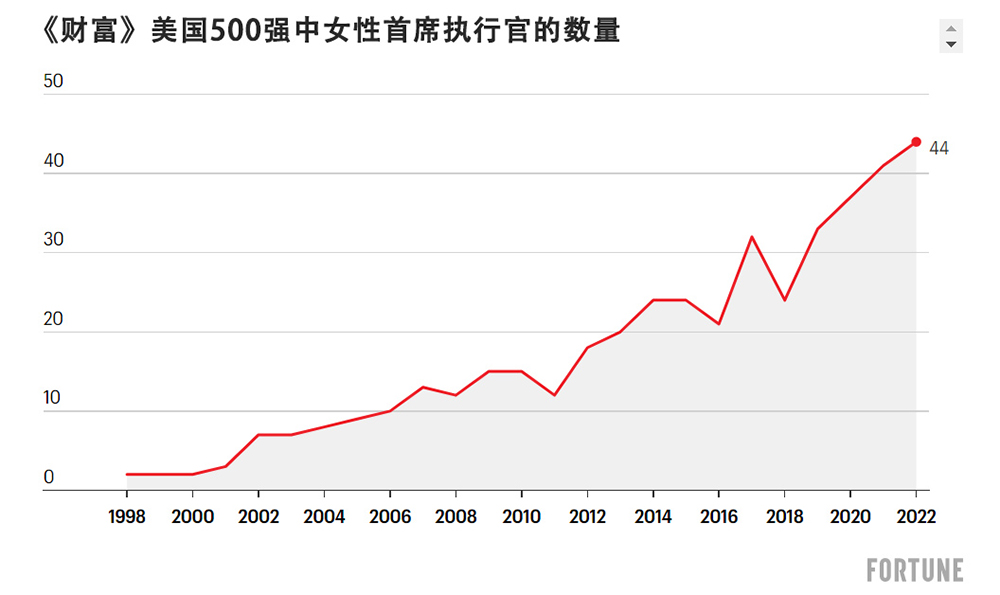
《财富》美国500强企业中由女性担任首席执行官的公司比例创下新高。在今年的《财富》美国500强榜单上,由女性执掌的公司数量达到了44家。不过这份榜单最值得注意的地方,就是这些女高管执掌的公司普遍风平浪静。这个迹象也表明,女性首席执行官在商界的地位日益稳定,甚至执掌《财富》美国500强级别的企业也不在话下。
《财富》美国500强是指美国营收额最高的500家公司,它也可以看作美国商业板块的一个缩影。虽然上榜的女性首席执行官数量时有波动,但它从某个角度也能够反映一个时代的商业文化。女性首席执行官的上榜数量是根据两个指标统计的:一是女性高管被聘用或者提拔为一家公司的首席执行官,二是女性首席执行官管理的企业登上《财富》美国500强榜单。
在2022年的《财富》美国500强榜单上,由女性担任首席执行官的公司有44家,占全部上榜企业的8.8%,略高于去年的8.2%(41家企业)。这个比例比20年前高了6倍(7家企业)。2018年,《财富》美国500强中由女性担任首席执行官的公司数量一度下滑至24家,但之后的四年则屡创新高。关注女性领导力问题的非盈利机构Catalyst的总裁兼首席执行官洛林·哈里顿说:“我们已经取得了稳步进展,但离我们期望的速度还差很远。”

今年的数据表明,美国商界的女高管人数正在缓慢而稳定的增长,只是不像去年那样夺人眼球。2021年的《财富》美国500强榜单上首次出现了两位黑人女性首席执行官,分别是沃博联(Walgreens Boots Alliance)的罗兹·布鲁尔和美国教师退休基金会(TIAA)的塔桑达·布朗·达克特。而CVS Health的首席执行官凯伦·林奇则拿下了女性在《财富》美国500强榜单上的最高排名。
虽然今年榜单的变化没有太多抢眼之处,但仍然有一些细节十分重要。上述三位女性,包括去年上榜企业中的多数女性首席执行官都保住了她们的工作。科蒂集团(Coty)的首席执行官苏·纳比和纳斯达克(Nasdaq)的首席执行官阿德娜·弗里德曼仍然在首席执行官的位子上干着,只是她们的公司跌出了《财富》美国500强。今年《财富》美国500强的最低营收门槛是63.9亿美元。
最新加入美国500强女掌门人阵营的,是Centene公司的首席执行官萨拉·伦敦,她曾任这家公司的董事、副董事长,在今年3月前任首席执行官因病离职后,她成了这家市值1260亿美元的医疗公司的首席执行官。另外,艾伦·库珀本月将成为Lincoln National的首席执行官,这是一家市值为192亿美元的金融服务公司,库珀在这家公司已经担任了10年的首席投资官。Jackson Financial公司是2021年从英国保诚集团(Prudential)分离出来的一家公司,它今年也跻身《财富》美国500强之列。它在2021年2月任命了一位名叫劳拉·普里斯科恩的女性首席执行官。女性品牌Bath and Body Work的前任首席执行官因为健康问题而离职后,也任命了萨拉·纳什作为临时首席执行官。纳什曾经是一名银行家,拥有Novagard公司的股份,她从2020年这家公司与麻烦缠身的品牌维多利亚的秘密(Victoria's Secret)剥离时起,便开始起担任它的董事。
在种族和民族多样性上,《财富》美国500强中的女性首席执行官的成份与去年大同小异。其中白人女性占了大多数。非白人女性首席执行官中,除了上面提到的布鲁尔和达克特,还有Gap公司(Gap Inc.)的首席执行官索尼娅·辛加尔、AMD公司(Advanced Micro Devices)的首席执行官苏姿丰、百胜中国(Yum China)的首席执行官屈翠容、Vertex Pharmaceuticals公司的首席执行官雷什玛·科瓦拉玛尼。
这些由女性管理的公司往往在规模上不算特大,至少很难挤进《财富》美国500强的前10位或者前100位。林奇是前五强中的唯一一位女性首席执行官,因为CVS Health去年的营收达到了2920亿美元,在《财富》美国500强上排在第4位。之后是沃尔格林,排在第16位。在《财富》美国500强前100位的企业中,女性管理的企业共有12家。在《财富》美国500强中,女性管理的医疗公司有5家,零售公司有7家,金融服务业公司有9家。(财富中文网)
译者:朴成奎
《财富》美国500强企业中由女性担任首席执行官的公司比例创下新高。在今年的《财富》美国500强榜单上,由女性执掌的公司数量达到了44家。不过这份榜单最值得注意的地方,就是这些女高管执掌的公司普遍风平浪静。这个迹象也表明,女性首席执行官在商界的地位日益稳定,甚至执掌《财富》美国500强级别的企业也不在话下。
《财富》美国500强是指美国营收额最高的500家公司,它也可以看作美国商业板块的一个缩影。虽然上榜的女性首席执行官数量时有波动,但它从某个角度也能够反映一个时代的商业文化。女性首席执行官的上榜数量是根据两个指标统计的:一是女性高管被聘用或者提拔为一家公司的首席执行官,二是女性首席执行官管理的企业登上《财富》美国500强榜单。
在2022年的《财富》美国500强榜单上,由女性担任首席执行官的公司有44家,占全部上榜企业的8.8%,略高于去年的8.2%(41家企业)。这个比例比20年前高了6倍(7家企业)。2018年,《财富》美国500强中由女性担任首席执行官的公司数量一度下滑至24家,但之后的四年则屡创新高。关注女性领导力问题的非盈利机构Catalyst的总裁兼首席执行官洛林·哈里顿说:“我们已经取得了稳步进展,但离我们期望的速度还差很远。”
今年的数据表明,美国商界的女高管人数正在缓慢而稳定的增长,只是不像去年那样夺人眼球。2021年的《财富》美国500强榜单上首次出现了两位黑人女性首席执行官,分别是沃博联(Walgreens Boots Alliance)的罗兹·布鲁尔和美国教师退休基金会(TIAA)的塔桑达·布朗·达克特。而CVS Health的首席执行官凯伦·林奇则拿下了女性在《财富》美国500强榜单上的最高排名。
虽然今年榜单的变化没有太多抢眼之处,但仍然有一些细节十分重要。上述三位女性,包括去年上榜企业中的多数女性首席执行官都保住了她们的工作。科蒂集团(Coty)的首席执行官苏·纳比和纳斯达克(Nasdaq)的首席执行官阿德娜·弗里德曼仍然在首席执行官的位子上干着,只是她们的公司跌出了《财富》美国500强。今年《财富》美国500强的最低营收门槛是63.9亿美元。
最新加入美国500强女掌门人阵营的,是Centene公司的首席执行官萨拉·伦敦,她曾任这家公司的董事、副董事长,在今年3月前任首席执行官因病离职后,她成了这家市值1260亿美元的医疗公司的首席执行官。另外,艾伦·库珀本月将成为Lincoln National的首席执行官,这是一家市值为192亿美元的金融服务公司,库珀在这家公司已经担任了10年的首席投资官。Jackson Financial公司是2021年从英国保诚集团(Prudential)分离出来的一家公司,它今年也跻身《财富》美国500强之列。它在2021年2月任命了一位名叫劳拉·普里斯科恩的女性首席执行官。女性品牌Bath and Body Work的前任首席执行官因为健康问题而离职后,也任命了萨拉·纳什作为临时首席执行官。纳什曾经是一名银行家,拥有Novagard公司的股份,她从2020年这家公司与麻烦缠身的品牌维多利亚的秘密(Victoria's Secret)剥离时起,便开始起担任它的董事。
在种族和民族多样性上,《财富》美国500强中的女性首席执行官的成份与去年大同小异。其中白人女性占了大多数。非白人女性首席执行官中,除了上面提到的布鲁尔和达克特,还有Gap公司(Gap Inc.)的首席执行官索尼娅·辛加尔、AMD公司(Advanced Micro Devices)的首席执行官苏姿丰、百胜中国(Yum China)的首席执行官屈翠容、Vertex Pharmaceuticals公司的首席执行官雷什玛·科瓦拉玛尼。
这些由女性管理的公司往往在规模上不算特大,至少很难挤进《财富》美国500强的前10位或者前100位。林奇是前五强中的唯一一位女性首席执行官,因为CVS Health去年的营收达到了2920亿美元,在《财富》美国500强上排在第4位。之后是沃尔格林,排在第16位。在《财富》美国500强前100位的企业中,女性管理的企业共有12家。在《财富》美国500强中,女性管理的医疗公司有5家,零售公司有7家,金融服务业公司有9家。(财富中文网)
译者:朴成奎
The share of woman-led Fortune 500 companies has hit a record high, with 44 female CEOs at the helm of some of the largest corporations in the U.S. But perhaps the biggest takeaway from this year's list is just how uneventful the changes in women's leadership are—a sign that female CEOs are finding stability and staying power atop Fortune 500 companies.
The Fortune 500, which ranks the 500 largest U.S. companies by revenue, is viewed as a microcosm of the overall U.S. business landscape. While the number of women CEOs who run businesses on the list can fluctuate throughout the year, it's a useful snapshot of the corporate leadership zeitgeist. Female CEOs join the rarified group when they're hired or promoted into the chief executive job, or if their company makes the Fortune 500 as a new entrant.
With 44 female chief executives spearheading America's largest companies, women now run 8.8% of businesses on the 2022 list. That's up from 8.2% last year, when women led 41 of the 500 companies, and six times their share two decades ago, when women led just seven Fortune 500 businesses. After dipping in 2018 to 24, the past four years have marked new record highs for female Fortune 500 chiefs. "We've made steady progress, but it's nowhere near the speed we'd like it to be," says Lorraine Hariton, president and CEO of the women's leadership nonprofit Catalyst.
Indeed, this year's numbers depict the continuation of slow-but-steady growth for women leaders in corporate America, albeit not as eventful as last year's ranking. The 2021 Fortune 500 list featured two Black women, Walgreens Boots Alliance CEO Roz Brewer and TIAA CEO Thasunda Brown Duckett, running companies on the list for the first time. Congruently, CVS Health CEO Karen Lynch earned the distinction of spearheading the highest-ranking Fortune 500 company ever led by a female chief executive.
Changes on this year's list are admittedly less exciting—but still important. All three of these women have retained their jobs, as have most other female CEOs who ran Fortune 500 companies at this time last year. Coty chief Sue Nabi and Nasdaq CEO Adena Friedman made the list last year but don't appear this year, though they do still hold their CEO titles; their companies simply fell off the Fortune 500. The minimum annual revenue to make the list was $6.39 billion this year.
One new entrant to this year's female CEO cohort is Centene's Sarah London, a former company board director and vice chairman who was tapped as the chief executive of the $126 billion health care company when her predecessor left for medical leave in March. Ellen Cooper this month will become CEO of Lincoln National, the $19.2 billion financial services business where she has spent a decade as chief investment officer. Jackson Financial joined the Fortune 500 this year after its 2021 separation from British financial services business Prudential; CEO Laura Prieskorn has led the business since February 2021. At Bath and Body Works—the former L Brands—Sarah Nash took over this month as interim CEO after her predecessor stepped down for health reasons. Nash, a former banker who owns the manufacturer Novagard, had served as a board director since 2020 when the company spun off the troubled Victoria's Secret.
Racial and ethnic diversity among Fortune 500 female CEOs is about the same as last year; the vast majority of women who run Fortune 500 businesses are white. Aside from Brewer and Duckett, women of color who run Fortune 500 companies include Gap Inc. CEO Sonia Syngal, Advanced Micro Devices CEO Lisa Su, Yum China CEO Joey Wat, and Vertex Pharmaceuticals CEO Reshma Kewalramani.
Women tend to run companies that are smaller than the corporate behemoths that make up the Fortune 10 or Fortune 100. Lynch is the only female CEO among the Fortune 5 thanks to CVS Health's $292 billion in revenue. After CVS, which ranks at No. 4, there's a significant gap before Walgreens appears as the next woman-led company, coming in at No. 16. Women run 12 Fortune 100 businesses in total and across the broader Fortune 500, they run five health care companies; seven retailers; and nine financial services businesses.






